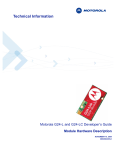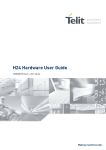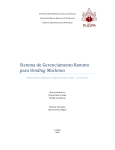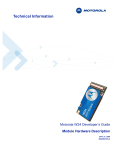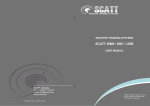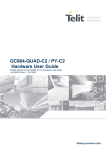Download Motorola AT Commands G24-L Specifications
Transcript
Hardware Interface Description Java Box Terminal Motorola G24 Cellular + GPS Engine Version: 02.01A Java Box Terminal_HD_V02.01 17.JUL.2008 Java Box Terminal Hardware Interface Description Released 1. Key Features of the Java Box Terminal Feature Implementation General Incorporates G24 module The Motorola G24 module handles all processing for audio, signal and data within the Java Box Terminal. Frequency bands Quad band: GSM 850/900/1800/1900MHz Power supply Single supply voltage 6V to 30V Operating temperature -20°C to +70°C ambient temperature Physical Dimensions: 98mm x 82m x 30m Weight: 160g , with battery 180g RoHS, WEEE All hardware components are fully compliant with the EU RoHS and WEEE Directives GSM / GPRS / EDGE features Data transfer GPRS • Multislot Class 10 CSD • 2.4, 4.8, 9.6 kbps • USSD PPP-stack for GPRS data transfer SMS • Point-to-point MT and MO • Text and PDU mode • Storage: SIM card plus 20 SMS locations in mobile equipment • Transmission of SMS alternatively over CSD or GPRS. Preferred mode can be user defined. Fax Group 3; Class 1 Audio Speech codecs: • Half rate HR • Full rate FR • Enhanced full rate EFR • Adaptive Multi Rate AMR Line echo cancellation Software AT commands TCP/IP Stack. Firmware update AT-Hayes GSM 07.05 and 07.07 TCP/IP stack Access by AT commands Upgradeable via serial interface / USB Java Box Terminal Hardware Interface Description Released Java Midlet Major benefits: integration into Java applications, no need for application microcontroller, extremely cost-efficient hardware and software design – ideal platform for industrial GSM applications. The memory space available for Java programs is10.0 MB flash file system and 1.8 MB RAM. Application code and data share the space in the flash file system and in RAM. Interface Serial interface • 8-wire modem interface with status and control lines, unbalanced, asynchronous • Fixed bit rates: 300 bps to 460,800 bps • Autobauding: 300 bps to 57,600 bps • Multiplex ability according to GSM 07.10 Multiplexer Protocol. I²C The I²C interface bus for transmission rates up to 100kbps. Audio Analog (Microphone amplifier ready, Speaker with 3W amplifier) 2.5mm output audio SIM interface Supported SIM cards: 3V Antenna Connected via antenna SMA connector or internal antenna Power on/off, Reset Power-on 1. Automatic on when power supply turn on ( IGN switch set on ) 2. Switch on via On/Off push button 3. On/Off line on IO interface connector Power-off Normal switch-off by AT or On/Off push button Reset Shutdown and reset by AT command Special features GPIO 16 I/O pins of the application interface are programmable as GPIO. Programming is done via AT commands. Alternatively, ADC input 3 Analog-to-Digital Converter input for measuring external voltages. Optional measuring supply voltage to the unit. Phonebook SIM and phone GPS High sensitivity for indoor reception up to -154 dBm. Fast TTFF's at low signal levels. Hot starts less then 2 seconds. Support 12- Channel GPS. GPS NMEA 0183 output format. Java Box Terminal Hardware Interface Description Released 2. Interface Description 2.1 Overview Java Box Terminal provides the following connectors for power supply, interface and antennas: 1. On/Off push button. 2. SMA connector (female) for GPS / WiFi antenna. 3. GPRS Led and Power Led. 4. 9-pole (female) SUB-D plug for RS-232 serial interface. 5. SMA connector (female) for GSM antenna. 6. 24-pole GPIO 3mm Micro Mate-N-LOK connector for GPIOs, I²C, ADC, Power. 7. 4-pole 3mm Micro Mate-N-LOK connector for power supply, RTS and Ignition input. 8. 6-pole RJ11 plug (female) for audio accessory, such as a Microphone and Speaker. 9. 8-pole RJ45 plug (female) for UART2 10. USB plug type-B 11. SIM card holder. 12. 2.5mm plug (female) for audio jack, such as a Headset. 5 2 4 3 1 Figure 1: Java Box Terminal front view 7 6 Figure 2: Java Box Terminal side A view 10 9 8 Figure 3: Java Box Terminal side B view Java Box Terminal Hardware Interface Description Released 12 DIN rail attachment Close option Figure 4: Java Box Terminal rear view 1- DIN rail attachment close DIN rail attachment Open option Figure 5: Java Box Terminal rear view 2 – DIN rail attachment open DIN rail attachment option Figure 6: Java Box Terminal rear view 3 – DIN rail attachment lock on DIN rail Battery and SIM drawer cover 11 2 holes 3mm for external attachment Figure 7: Java Box Terminal bottom view Java Box Terminal Hardware Interface Description Released 2.2 Block Diagram Figure 3 shows a block diagram of a sample configuration that incorporates a Java Box Terminal and typical accessories. Antenna GSM On/Off Key SIM G24 SMA Antenna GPS USB UART_2 SMA GPS GPIO Audio Power USB PC UART_1 UART 8 pin RJ45 USB B-Type 9 pin D-Type Com/ RS232 RS232 No. 1 SW2 3 way selection RS232 No. 2 power Led GPRS Led Speaker 4 ohm Audio 24 pin 3w Amp Speaker LDO 3.8V Microphone GPIO 1-16 Microphone Battery Switch 6 pin RJ11 ADC1 ADC2 ADC3 LIPO Battery 900ma/H 3.7V Audio 2.5 mm connector For Headset RESET_N JAVA Reset IGNITION Battery Charger Option Input / Output Power 6-30VDC Power DC to DC 5V output Ground Input / Output Power 6-30VDC To G24 From G24 Input 12v IGNISTION Output RESET_N 4 pin Figure 8: Block diagram Java Box Java Box Terminal Hardware Interface Description Released 24 PIN 70 PIN G24 OEM / Connector Pin # Connector Pin # G24-Lite 1 28 GPIO1 2 30 GPIO2 3 32 GPIO3 4 34 GPIO4 5 36 GPIO5 6 38 GPIO6 7 40 GPIO7 8 42 GPIO8 9 41 ANT_DET 10 49 GPRS 11 26 WKUPO_N 12 1 GND 13 23 RI_N 14 13 DSR_N 15 19 DTR_N 16 17 DCD_N 17 16 WKUPI_N 18 37 ADC1 19 43 ADC2 20 47 ADC3 21 25 RESET_N 22 39 TXEN_N 23 51 IGN 24 VIN Java Box GPIO1 GPIO2 GPIO3 GPIO4 GPIO5 GPIO6 GPIO7 GPIO8 GPIO9 GPIO10 GPIO11 GND GPIO12 GPIO13 GPIO14 GPIO15 GPIO16 (JTool) ADC1 ADC2 ADC3 RESET_N TXEN_N IGN VIN Table 1: Pin assignment 24 pin connector to 70 pin G24 Java Box Terminal Hardware Interface Description Released 2.3 Power Supply The power supply of the Java Box Terminal has to be a single voltage source of POWER 6V-30V capable of providing a peak during an active transmission. The Java Box Terminal is protected from supply reversal voltage. An internal fuse ensures an electrical safety according to EN60950. This fuse is not removable. A fast acting fuse 0.8A with melting is necessary to use with the Java Box Terminal at a 24V power supply system for vehicles. The power supply must be compliant with the EN60950 guidelines. Pin 1 2 3 Signal name POWER IGNITION GND 4 RESET_N Direction In In Out Use Input Power supply range 6-30V Power on console connected to input 12V Ground Output notify if modem ON Table 2: Pin assignment of the plug for power supply and relay 4 3 2 1 Pin assignment 1 – Power 2 – IGNITION 3 – GND 4 – RESET_N Figure 9: Male 4-pole plug for power supply. 2.3.1 Supply voltage requirements The DC power supply must be connected to the POWER input: • Input voltage range 6 - 30V DC • Nominal Voltage 12V DC • Power Supply current rating: min. 1,2A @12V • Power Supply ripple: max. 120mV • Input current in idle mode: 20mA @ 12V • Input average current in communication mode: 100mA @ 12V Java Box Terminal Hardware Interface Description Released 2.3.2 Block Diagram Battery management On/Off Key G24 RESET_N Battery power IGN Linear Power supply output 3.8V FET Control switch 5V Power sense fail 24 pin Connector ON when input power fail LIPI Battery 3.7V 900mA/h Battery Charger IGNITION RESET_N GPIO control DC/DC Off/On Enable Power 5V DC to DC output 5V Power 6-30VDC Polly Fuse 1.1A GND GROUND IGNITION Input 12v IGNITION Output RESET_N 4 pin Figure 9: Block diagram Java Box energy management Java Box Terminal Hardware Interface Description Released 2.3.3 Block Diagram Battery management flow chart explanation Java Box Power supply Input power 6-30 VDC, the input power pass via poly fuse and over voltage and reverse polarity protection. The DC/DC reduce the power to 5V, the 5V supply for two separate direction, A. First direction to Linear power supply that reduce the power to 3.8V, this power supply will hold the unit power on regular base B. Second direction to battery charger, the battery charger supply the LIPO battery the correct power management, battery selected 960ma/H max size 38*39*6.1mm with internal management card, on normal operation the battery will be charge to maximum 4.1V, the battery is use for backup and supply the power to the modem only when the main power fail or when the modem turn off the DC/DC power supply. The Java Box automatically will switch from linear power supply to battery operation when the DC/DC power supply stops 5V output. 2.3.4 Battery charger Battery charger on normal operation the battery will be charge to maximum 4.1V, the battery is use for backup and supply the power to the modem only when the main power fail or when the modem turn off the DC/DC power supply. Charge condition Charge in progress Charge done Description When the device is in Pre-Charge or fast- Charge status When the charging current goes lower than the IENDTH LD1- Green LD2- Red ON OFF OFF ON Stand By mode When the input voltage goes under VBAT - 50mV OFF OFF Bad battery temperature When the voltage on the TH pin is out of the programmable window, in accordance with the NTC ON ON Battery absent When the battery pack is removed ON ON Over time When Battery did not charge fully on the given time ON ON Table 3: Status LEDs Indications Java Box Terminal Hardware Interface Description Released 2.4 Switch on Java Box Terminal There are several ways to turn on the Java Box Terminal: • Switch on via On/Off push button, switch on the Java Box Terminal by pressing the On/Off key signal line must be asserted for at least 2000 ms and then released. • Switch on via IGNITION line on the 24pin connector and the 4 pin connector. Java Box Terminal Pull Up SW1 – 1 ( IGN ) G24 24 pin connector Pin number 23 IGNITION pin 51 4 pin connector Pin number 2 On/Off pin 53 Front panel On/Off switch Figure 11: On/Off control 2.4.1 Reset Java Box Terminal An easy way to reset the Java Box Terminal is entering the command AT+CFUN=0,1 2.4.2 Switch Off Java Box Terminal There are several ways to turn off the java Box Terminal: • Software controlled shutdown by AT command: AT+MRST The AT command lets Java Box Terminal log off from the network and allows the software to enter into a the secure state and safe data before disconnecting the power supply. The mode is referred to Power-down mode. • Via On/Off push button. The Java Box Terminal will be switched off by pressing the On/Off push button or by activating the On/Off signal for >2s. • Via IGNITION line. The Java Box Terminal will be switched off by IGNITION input line connected to GND. Java Box Terminal Hardware Interface Description Released 2.4.3 Disconnecting Power Supply Before disconnecting the power supply from the POWER pin make sure the Java Box Terminal is in a safe condition. A safe condition is waiting 2s after the "SHUTDOWN" result code has been indicated. 2.5 GPIO Interface Specification All General Purpose input / output are connected to the related pins of the Motorola G24 module over a 100 Ohms series resistor. The following table shows the logic level specifications in the Java Box terminal interface circuits: LEVEL Input high level Input low level Output high level Output low level MIN 2.0V 0V 2.5V 0V MAX 3.0V 0.4V 2.8V 0.2V Table 4: GPIO Signal states level apply to G24 OEM All GPIO normally HIGH with internal pull up resistor of 22k, to indicate that a LOW signal on the GPIO connect the GPIO to GND, for HIGH signal leave the GPIO open. 2.6 RS232 number 1__ Interface G24 UART1 The serial interface RS232 number 1 of the Java Box Terminal is intended for the communication between the GSM module and the host application. This RS232 interface is a data and control interface for transmitting data, AT commands and providing multiplexed channels. EMC immunity complies with the vehicular environment requirements according to EN 301 489-7. The user interface of the Java Box Terminal is accessible from a Data Terminal Equipment DTE connected to the RS232 interface and it is managed by AT commands according to the GSM 07.07 and 07.05 specification and the supported commands are listed in the AT Commands Reference Guide. Pin no. 1 2 3 4 5 6 7 8 9 Figure 12: Pin assignment RS-232 (D-Sub 9-pole female) Signal name I/O Function of application DCD RXD TXD DTR GND DSR RTS CTS RING O O I I O I O O Data Carrier Detected Receive Data Transmit Data Data Terminal Ready Ground Data Set Ready Request To Send Clear To Send Ring Indication Table 5: D-Sub 9-pole female RS232 Connector type on the terminal is: • RS-232 through D9-pin female • Baud rate from 300 to 460,600 bit/s • Autobauding (300 to 57,600 bit/s) • Short circuit (to Ground) protection on all outputs. • Input voltage range: -12V to +12V Note: some of the RRS232 pin as dual use as GPIO, refer to table 1. Java Box Terminal Hardware Interface Description Released 2.6.1 The PC as Data Terminal Equipment (DTE) The software application for using the PC RS232 standard serial interface (COM-port) as Data Terminal Equipment (DTE) is usually Hyper Terminal. Connect using the COM-port to which the Java Box Terminal is connected with the following settings: 2.6.2 RS232 number 2__ Interface G24 UART2 or GPS The serial interface RS232 number 2 of the Java Box Terminal is intended for the communication between the G24 GSM module UART2 and the host application. This RS-232 interface is a data and control interface for transmitting data, AT commands and providing multiplexed channels. Alternative the serial interface RS232 number 2 of the Java Box Terminal can be switch with SW2 to be connect to the GPS. Java Box Terminal Hardware Interface Description Released 2.6.3 SW2 switch selection SW2 select 3 options, only 2 switches allow to be ON at the same time. a. S1 and S2 switch ON, G24 UART2 connect to GPS UART. b. S3 and S4 switch ON, GPS UART connect to PC RS232_2. c. S5 and S6 switch ON, G24 UART2 connect to PC RS232_2. G24 RS232 No. 2 UART_2 RTS RTS CTS UART_2 RX CTS Com/ RS232 S4 S3 TX SW2 RX S1 S2 S6 RX PC TX S5 TX UART GPS SW1 - to enable switch to ON 1. IGN 2. Do Not Use 3. GPIO8 4. WKUP_I 5. GPIO1 6. DC/DC enable by IGN GPS Shield SIM Drawer ON OFF SW1 1 SW2 1 ON Java Box Terminal Hardware Interface Description Released OFF 2.7 Audio Interface The audio interface provides one analog input for a microphone and one analog output for Speaker. • The microphone input not balanced. • The Speaker output is balanced. • For electret microphone a supply source is implemented by the G24 Modem. • For speaker 3W amplifier implemented output 4ohm. 123456 Pin assignment 1 – GND 2 - Microphone3 - Speaker 4ohm 3w 4 - Speaker 4ohm 3w 5 - Microphone+ 6 - 3.8V Figure 13: Audio RJ11 plug (6-pole female) Java Box 6 5 4 3 2 1 RJ11 EAR_HF+ 3.8V 3W AMP MIC + Speaker + Speaker MIC - EAR_HFMIC_HF+ MIC_HF- GND SPKR_N pin 67 SPKR_P pin 69 MIC pin 61 MICN pin 16 Figure 14: Audio block diagram Sample Commands for Java Box Audio operation 1 2 AT+CLVL= AT+MMICG= 0-7 0 - 31 Speaker Gain Microphone Gain For more Audio command refer to G24 AT command guide page 319 2.7.1 Supported Audio Modes The audio interface can be configured by inserting the 2.5mm Jack the Audio will be connected to the Headset, when this jack is out Audio will connected to RJ11 output. Java Box Terminal Hardware Interface Description Released 2.7 Antenna Interface In order to send or receive data connect an external RF antenna to the SMA connector which is internally connected to the RF signal of the GSM module. Please consider that the recommended antenna equipment has been chosen to achieve optimum RF performance when operating the Java Box Terminal. Frequency range Bandwidth Gain Impedance Input power VSWR absolute max VSWR recommended Depending by frequency band(s) provided by the network operator, the customer shall use the most suitable antenna for that/those band(s) 80 MHz in EGSM 900, 70 MHz if GSM 850, 170 MHz in DCS, 140 MHz PCS band 1.5dBi <= Gain < 3dBi (referenced to isotropic radiator) 50 Ohm > 2 W peak power <= 10:1 <= 2:1 Table 6: Antenna speciation 2.8.1 Operating Frequency The operating frequencies in GSM, DCS, PCS modes are conform to the GSM specifications. Mode E-GSM-900 GSM-850 DCS-1800 PCS-1900 Freq. TX (MHz) 890.0 - 914.8 880.2 - 889.8 824.2 – 848.8 1710.2 - 1784.8 1850.2 - 1909.8 Freq. RX (MHz) 935.0 - 959.8 925.2 - 934.8 969.2 – 893.8 1805.2 - 1879.8 1930.2 - 1989.8 Channels (ARFC) 0 – 124 975 - 1023 128 - 251 512 – 885 512 - 810 TX - RX offset 45 MHz 45 MHz 45 MHz 95 MHz 80 MHz Table 7: Operating frequencies Transmitter output power GSM–850 / 900 The Java Box modem in GSM–850/900 operating mode are class 4 in accordance with the specification which determine the nominal 2W peak RF power (+33dBm) on 50 Ohm. DCS–1800 / PCS-1900 The Java Box modem in DCS–1800/PCS-1900 operating mode are of class 1 in accordance with the specifications which determine the nominal 1W peak RF power (+30dBm) on 50 Ohm. Reference sensitivity GSM–850 / 900 The sensitivity of the Java Box modem according to the specifications for the class 4 GSM–850/900 portable terminals is –107dBm typical in normal operating conditions. DCS–1800 / PCS-1900 The sensitivity of the Java Box modem according to the specifications for the class 1 portable terminals DCS-1800 / PCS-1900 is –106 dBm typical in normal operating conditions. 2.9 SIM Interface The SIM interface is intended for 3V SIM cards. The card holder is a five wire interface according to GSM 11.11. A sixth pin has been added to detect whether or not the SIM card drawer is inserted. Removing and inserting the SIM card during operation requires the software to be reinitialized. Therefore, after reinserting the SIM card it is necessary to restart Java Box Terminal. Java Box Hardware Interface Description Released 2.10 IO Interface The following interfaces and functions are provided via the IO interface connector. 24 13 12 GPIO 24 PIN Connector 1 Figure 15: GPIO interface connector 24 pin Pin 1 2 3 4 5 6 7 8 9 10 11 12 13 14 15 16 17 18 19 20 21 22 23 24 Signal name GPIO1 GPIO2 GPIO3 GPIO4 GPIO5 GPIO6 GPIO7 GPIO8 GPIO9 GPIO10 GPIO11 GND GPIO12 GPIO13 GPIO14 GPIO15 GPIO16 ADC1 ADC2 ADC3 TXEN_N JAVA_RESET IGNITION VIN I/O I/O I/O I/O I/O I/O I/O I/O I/O I/O I/O I/O Description GPIO input or output conferrable GPIO input or output conferrable GPIO input or output conferrable GPIO input or output conferrable GPIO input or output conferrable GPIO input or output conferrable GPIO input or output conferrable GPIO input or output conferrable GPIO input or output conferrable GPIO input or output conferrable GPIO input or output conferrable I/O GPIO input or output conferrable I/O GPIO input or output conferrable I/O GPIO input or output conferrable I/O GPIO input or output conferrable I/O GPIO input or output conferrable I analog input 1 I analog input 2 I analog input 3 O Modem G24 on or off status I Reset Java MIDLET I Start Modem I Input Power Supply Table 8: Assignment of the IO interface connector 2.11 Status LED Green LED displays the network status of the Java Box Terminal. Green LED status permanently on permanently off Device Status Unit is active device off Table 9: Green LED Status Red LED displays the operating status of the GPRS in the Java Box Terminal, option internal resistor for GPIO8 indication. Java Box Hardware Interface Description Released 3. GPS 3.1 GPS Antenna Requirements The GPS module is not provided with an internal LNA amplifier. The use of an active antenna is important to achieve a good performance. The module is provided of an Antenna supply circuit. As suggested on the Product Description the external active antenna for a GPS device shall fulfill the following requirements: ANTENNA REQUIREMENTS Frequency range Bandwidth Gain Impedance Amplification Supply voltage Current consumption 1575.42 MHz (GPS L1) +- 1.023 MHz 1.5 dBi < Gain < 4.5 dBi 50 ohm Typical 25dB (max 27dB) Must accept from 3 to 5 V DC Typical 20 mA (40 mA max) Table 10: GPS Antenna requirements 4. Mechanical Characteristics Weight Dimensions (max) L x W x H Temperature range Protection class Mechanical vibrations Amplitude Air humidity Class of flammability Casing material 160g 98 mm x 82mm x 30mm -20°C to +70°C ambient temperature IP40 Avoid exposing JAVA BOX Terminal to liquid or moisture 7.5mm at 5-200Hz sinus 5% - 85% UL94 HB PC/ABS Cycoloy 1200 HF Table 11: Mechanical characteristics Figure 19: Mechanical measurements Java Box Terminal Hardware Interface Description Released 5. ACCSESSORIES 5.1 24 pins Interface Connector This chapter provides specifications for the 24-pin IO interface connector which serves the GPIO interfaces of the Terminal. The type of the receptacle assembled on the JAVA BOX Terminal is 24 pin Micro Mate-N-LOK 3mm from MOLEX. Mating headers can be chosen from the MOLEX Micro Mate-N-LOK Series. For latest product information http://www.molex.com 5.2 Power Supply This chapter provides specifications for the power supply which serves the Terminal. The power supply we recommended is 12V 1.2A part number JB12V1.2A. The type of the receptacle assembled on the JAVA BOX Terminal is 4 pin Micro Mate-N-LOK 3mm from MOLEX. Mating headers can be chosen from the MOLEX Micro Mate-N-LOK Series. For latest product information http://www.molex.com 5.3 Battery This chapter provides specifications for the Battery which serves the Terminal. The LIPO battery we recommended is 3.7V 900mA/h part number JBbattery900 mechanical size 38*39*6.1mm. The type of the receptacle assembled on the JAVA BOX Terminal is 3 pin Micro Mate-N-LOK 2.0mm from MOLEX. Mating headers can be chosen from the MOLEX Micro Mate-N-LOK Series. For latest product information http://www.molex.com 5.4 Power cable This chapter provides specifications for the power cable which serves the Terminal. The power supply we recommended is 30V 1.2A part number JBPowerCable. The type of the receptacle assembled on the JAVA BOX Terminal is 4 pin Micro Mate-N-LOK 3mm from MOLEX. Mating headers can be chosen from the MOLEX Micro Mate-N-LOK Series. For latest product information http://www.molex.com 5.5 GSM antenna This chapter provides specifications for the GSM antennas which serves the Terminal. We recommended 4 types of GSM antennas with SMA connector: 900/1800Mhz 2.5dBm 3 meter cable part number JBantenna2.5db3M9001800. 850/1900Mhz 2.5dBm 3 meter cable part number JBantenna2.5db3M8501900. 900/1800/1900Mhz 1dBm 5 cm 90 degree SMA part number JBantenna1db5m90018001900SMA. 5.6 GPS antenna This chapter provides specifications for the GPS antennas which serves the Terminal. We recommended 2 types of GPS antennas with SMA connector: 1500Mhz 5 meter cable part number GBantennaGPS5m. 5.7 RS232 cable UART 1 This chapter provides specifications for the RS232 Cable UART 1 which serves the Terminal. We recommended Cable 9 pin D-Type male to female RS232_1 cable 2 meter cable part number GBrs232Dytpe2m 5.7 RS232 cable UART 2 This chapter provides specifications for the RS232 Cable UART 2 which serves the Terminal. We recommended Cable RJ45 male to female 9 pin D-Type RS232_2 cable 1 meter cable part number GBrs232RJ451m 5.7 RJ11 Audio cable This chapter provides specifications for the AUDIO Cable RJ11 which serves the Terminal. We recommended Cable RJ11 male to male 6 pin AUDIO Cable RJ11 20cm meter cable part number GBaudioRJ11m 5.7 USB cable This chapter provides specifications for the USB Cable which serves the Terminal. We recommended Cable USB male USB type B to male USB type A USB Cable 1 meter cable part number GBUSB1m Java Box Terminal Hardware Interface Description Released 6. SAFETY RECOMMANDATIONS READ CAREFULLY Be sure the use of this product is allowed in the country and in the environment required. The use of this product may be dangerous and has to be avoided in the following areas: Where it can interfere with other electronic devices in environments such as hospitals, airports, aircrafts, etc. Where there is risk of explosion such as gasoline stations, oil refineries, etc It is responsibility of the user to enforce the country regulation and the specific environment regulation. Do not disassemble the product; any mark of tampering will compromise the warranty validity. We recommend following the instructions of the hardware user guides for a correct wiring of the product. The product has to be supplied with a stabilized voltage source and the wiring has to be conforming to the security and fire prevention regulations. The product has to be handled with care, avoiding any contact with the pins because electrostatic discharges may damage the product itself. Same cautions have to be taken for the SIM, checking carefully the instruction for its use. Do not insert or remove the SIM when the product is in power saving mode. The system integrator is responsible of the functioning of the final product; therefore, care has to be taken to the external components of the module, as well as of any project or installation issue, because the risk of disturbing the GSM network or external devices or having impact on the security. Should there be any doubt, please refer to the technical documentation and the regulations in force. Every module has to be equipped with a proper antenna with specific characteristics. The antenna has to be installed with care in order to avoid any interference with other electronic devices and has to guarantee a minimum distance from the body (20 cm). In case of this requirement cannot be satisfied, the system integrator has to assess the final product against the SAR regulation. The European Community provides some Directives for the electronic equipments introduced on the market. All the relevant information’s are available on the European Community website: http://europa.eu.int/comm/enterprise/rtte/dir99-5.htm The text of the Directive 99/05 regarding telecommunication equipments is available, while the applicable Directives (Low Voltage and EMC) are available at: http://europa.eu.int/comm/enterprise/electr_equipment/index_en.htm Java Box Terminal Hardware Interface Description Released 7. JAVA BOX GPS Options This chapter provides options that can be use on the JAVA BOX GPS. 7.1 Battery Source Power 7.1.1 Battery Power Single 3.7V LIPO cell battery type is use for supplying the power to the JAVA BOX The battery capacity 900mAh. 7.1.2 Battery Charge control Circuitry The charging process for LIPO Battery divided into 4 phases: • Qualification and trickle charging • Fast charge 1 - constant current • Final charge - constant voltage or pulsed charging • Maintenance charge The qualification process down by special internal chip, this chip is battery charger voltage regulator. moreover all these operations should start only if battery temperature is inside a charging range, usually 5°C - 45°C. The JAVA BOX measures the temperature of its internal component, in order to satisfy this last requirement, it's not exactly the same as the battery temperature but in common application the two temperature should not differ too much and the charging temperature range should be guaranteed. Battery and SIM drawer Battery 900ma/H Battery connector Figure 20: JAVA BOX Terminal bottom view LIPO Battery location Java Box Terminal Hardware Interface Description Released





















